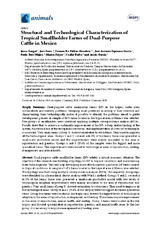Structural and Technological Characterization of Tropical Smallholder Farms of Dual-Purpose Cattle in Mexico
Autor
Rangel Quintos, Jaime
Perea, José
Pablos-Heredero, Carmen de
Espinosa García, José Antonio
Toro Mújica, Paula Macarena
Feijoo, Marisa
Barba Capote, C.J.
García Martínez, Antón Rafael
Editor
MDPIFecha
2020Materia
ALC countriesSmallholders
Dual purpose
Tropical zone
Technological innovation
METS:
Mostrar el registro METSPREMIS:
Mostrar el registro PREMISMetadatos
Mostrar el registro completo del ítemResumen
Dual-purpose cattle smallholder farms (DP) exhibit a critical economic situation. The objective of this research was building a typology for DP in tropical conditions and characterizing them technologically. This will help developing more effective public policies in DP farms located in tropical conditions. A sample of 1.475 farms located in the tropical area of Mexico was selected. The typology was built using multiple correspondence analysis (MCA). Subsequently, five groups were identified by a hierarchical cluster analysis with Ward’s method. Groups 1 and 2, covered a 46.5% of the farms; these ones presented a small-scale productive model with low levels of technological adoption, improvements were mainly associated to the area of reproduction and genetics. Very small farms (Group 3) showed orientation to subsistence. They need to improve all the technological areas. Groups 4 and 5 (29.4% of the sample) were the biggest and more specialized farms. Group four farms were located in dry tropics and showed the highest levels of technological adoption in the areas of reproduction, management, and feeding. These farms require improvement in the areas of reproduction, animal health, and feeding. Group 5 farms were located in the wet tropics and showed specialization in reproduction, genetics, and animal health areas. In this last group, it is necessary to improve management and feeding areas.

